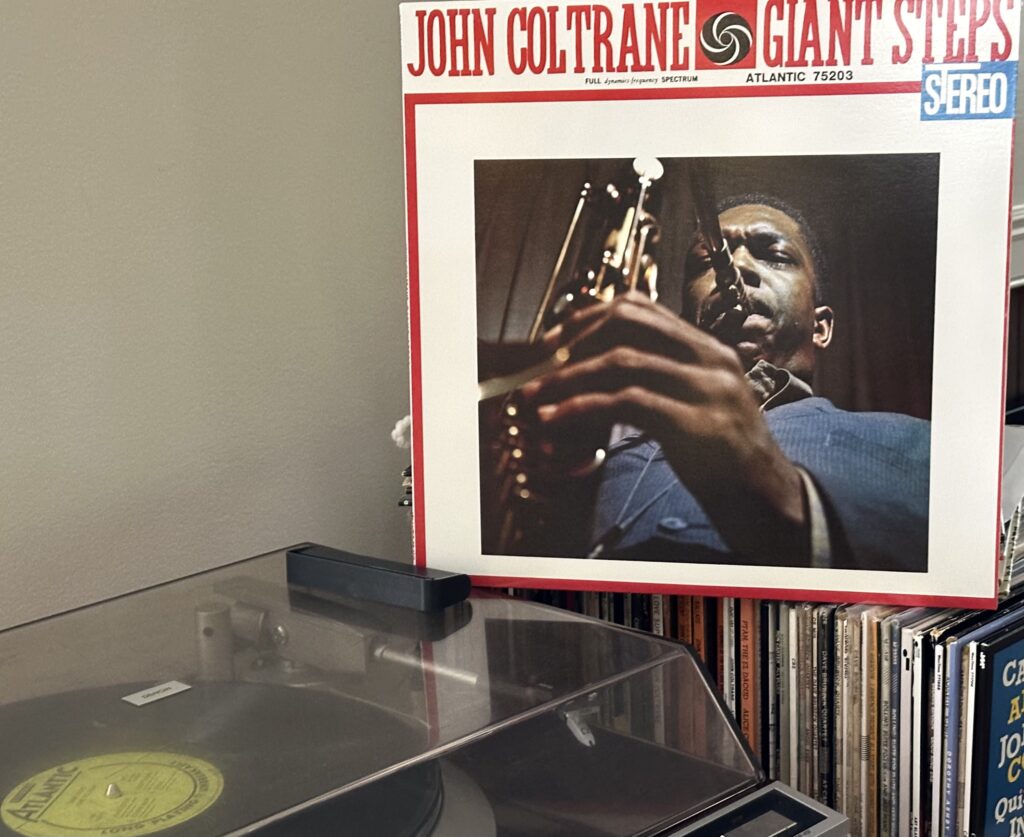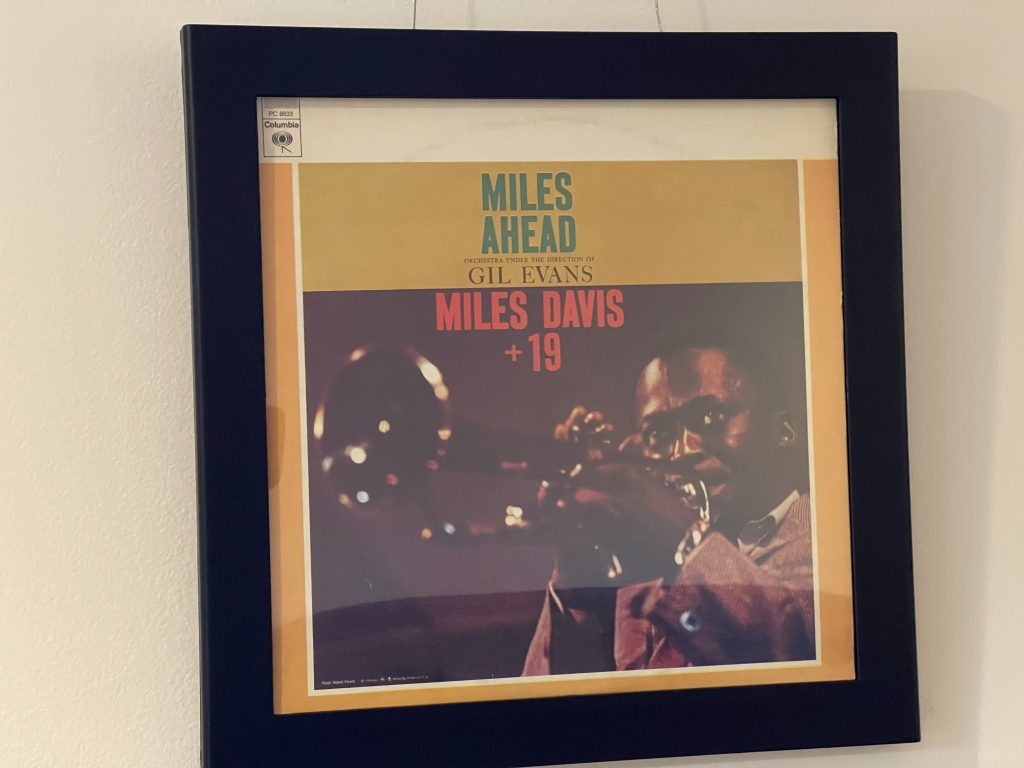
Album of the Week, January 6, 2024
When we last saw John Coltrane, the tenor saxophonist was taking extended solos and testing his freedom from the bandstand while ostensibly on a tour of Europe with Miles Davis. That session was recorded on March 24, 1960, and it came just weeks after the release of today’s album, Trane’s first for Atlantic Records. But the sessions for Giant Steps started years earlier — just a month after the last session for Kind of Blue. The recordings here demonstrate a jazz composer and performer just beginning to stretch out and realize that his span was far greater than previously demonstrated.
In 1959, Trane signed a contract as a leader with Atlantic Records. The label, founded by Turkish-American businessman and music fan Ahmet Ertegun with record executive Herb Abrahamson, had its roots in the R&B music that Ertegun loved; among its first hits was a re-recording of a hit song from his prior label Harlem Records, the McGhee Brothers “Drinking Wine, Spo-Dee-O-Dee.” But jazz was always one of Ertegun’s favored genres, and when he brought his older brother Nesuhi into the label as head of A&R in January 1955, the label expanded its focus on jazz artists, bringing in Shorty Rogers, Jimmy Giuffre, Herbie Mann, Les McCann, Charles Mingus, and, in 1959, Coltrane.
The first sessions for Giant Steps actually took place in between sessions for Kind of Blue, on April 1, 1959, in Atlantic Studios in New York City. The band included Cedar Walton on piano, Lex Humphries on drums, and Trane’s bandmate from Miles’ group Paul Chambers on bass. The session yielded recordings of three tracks, but Trane didn’t like the results and they weren’t heard until they began surfacing as alternate takes on CD reissues of the albums years later.
Trane returned to the studio two weeks after the last Kind of Blue sessions, on May 4 and 5, 1959, with Tommy Flanagan on piano and Art Taylor on drums alongside Chambers. This configuration was more successful, recording “Spiral,” “Cousin Mary,” “Countdown,” “Syeeda’s Song Flute,” “Mr. P.C.”, and “Giant Steps.” To complete the album, Trane re-entered the studio on December 2, 1959 to record “Naima,” this time with Miles’ entire rhythm section—Wynton Kelly, Jimmy Cobb and Chambers.
You can read a lot about the music theory behind “Giant Steps.” Trane’s innovative series of chord changes, moving through changes of thirds and fifths, and the bass line which descended in larger intervals than normal, would be the foundation for much of his early sound. Listening to the track without one’s music theory ears on, two things stand out: the tune is remarkably catchy, with the rising cadence that brings it back to the tonic suggesting a sprightly, upbeat dance; and the tempo is fearsome, particularly as Coltrane’s solo takes flight. Alternate recordings for the session reveal that Trane worked out the melodic patterns that he would play over the chords in advance; by contrast, Tommy Flanagan’s solo in the master take sounds unrehearsed, with hesitant right hand runs over each of the chords separated by gaps at each chord change. At least Flanagan attempted a solo: it is speculated that one of the reasons Trane didn’t use the sessions with Walton and Humphries was that Walton refused to solo on “Giant Steps,” despite having been given the chords in advance.
“Cousin Mary,” by contrast, plays like a more straight ahead modal blues, largely staying in the same tonality throughout, and accompanied by a killer walking bass line by Chambers and brisk snare and bass drum work by Taylor. Flanagan provides elegant stabs at the chords under the horn section and takes a solo that digs into the minor second transition in the last measures of the tune. Chambers’ solo starts as a straightforward “walk” of the blues but soon broadens as he leans into the blue note. Listen for the way the rhythm section leaves space at the end of each phrase in the final chorus, as though they are breathing with Trane.
Taylor’s drums open “Countdown” with a fierce solo; he steps back to cymbals and snare as Trane enters, seemingly playing a headlong free stream of notes outside of a melodic structure. When Flanagan and Chambers enter, it becomes apparent that the whole thing is an improvisation off a set of chords that are strongly influenced by the “Giant Steps” chords. Finally Trane blows the melody, and the song is out in less than two minutes and 30 seconds. It’s a mind blower.
By contrast, “Spiral” is more measured, but no less innovative. Trane’s melody is built around a descending chromatic scale, with ornamentation at each step that implies the spiral of the title. The chords descend as well, but the bass stays on a suspended fourth below the tonic. Trane’s “sheets of sound” solo stays pretty close to the chords in the first go round, but by the third chorus he’s regularly ascending up to a minor third above the tonic, then back down. Flanagan’s solo is surer here, leaning into the minor mode. The pianist steps back to just sketching out the chords as Chambers plays a counter-melody around the changes.
“Syeeda’s Song Flute,” opening Side 2, is the longest composition on the album and the most unusual. The tune (named after Coltrane’s adopted daughter) is deceptively simple, beginning with the rhythm section playing only on the second (later second and fourth) beat of each measure, and Trane playing a melody primarily consisting of even 8th notes. As the tune comes into the last four measures it changes key, moving from G down to E, before returning to the tonic. Tommy Flanagan’s solo moves nimbly around the changes, sounding at home in this setting; it’s the best work he does on the record. Paul Chambers gets a lengthy solo here as well, elaborating the gnomic wisdom in those chord changes, and bringing not only a more elaborate meter but also strategically timed moments of breath throughout the solo. When Trane returns, he plays the changes as a single note, on the downbeat of each measure, before leaning into the chorus.
“Naima” is named after and dedicated to Coltrane’s first wife. It’s a ballad, played slowly and sensitively (no sheets of sound here) above an E♭pedal tone that moves to a B♭ in the middle bars. The performance here, the only one from that December 2 session with Miles’ band, is one of those moments in Trane’s discography where you can hear him subtracting elements from the song to get to the core of what he had to say. It feels centered and quiet from beginning to end, including in Wynton Kelly’s piano solo after the first chorus.
“Mr. P.C.” wraps the album as a fast blues. Named after Chambers, it’s a straight ahead tune that hides tricky changes and fast exchanges in its solos. It also bears a strong familial resemblance in its first four bars to Robert MacGimsey’s 1931 song “Shadrack,” especially as performed by Sonny Rollins on his 1951 Sonny Rollins Quartet album. But Trane’s tune takes those four bars, transposes them and lands the tune someplace entirely different; his solo ends up exploring more of the outer reaches of the cosmos than the inside of Nebuchadnezzar’s furnace. Flanagan’s piano takes over the exploration, elegantly exploring the edges of the chords and slipping in a passing Bach reference at one point. Trane returns and trades fours with Taylor for an entire chorus. Throughout, Chambers provides a consistently elevated, but even, pulse; he does not take a solo on the tune named for him.
Trane’s first Atlantic album, and the first solo recording of his post-Miles career, hints at some of the wide open vistas ahead of him. With one foot in the modal statements of Miles’ band at the time and the other foot embarking on a long search for unique expression, Giant Steps promises many moments of exploration ahead. We’ll dig into another moment in those early explorations next time.
You can listen to today’s album here:

